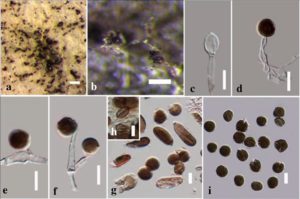Arthrinium paraphaeospermum Senan., & K.D. Hyde, in Hyde et al., Fungal Diversity 80: 198 (2016)
Index Fungorum number: IF 552137, Facesoffungi number: FoF 02459
Etymology – In reference to the large conidia and conidiogenous cells and morphological similarity to the A. phaeospermum.
Saprobic on bamboo. Sexual morph Undetermined. Asexual morph Mycelium consisting of smooth, hyaline, branched, septate, 3–5 lm diam. hyphae. Conidiophores reduced to conidiogenous cells. Conidiogenous cells 25–30 9 4–6 μm (x = 27 9 4.7 μm ), basauxic, aggregated in clusters on hyphae, hyaline, smooth, elongated, conical to ampulliform. Conidia 10–19 μm diam., (x = 13 μm ) brown, smooth, somewhat granular, globose to ellipsoid in surface view, with a median scar, lenticular in side view, with a pale equatorial slit. Sterile cells 20–30 × 9–13 μm (x = 24 × 11 μm ), forming on solitary loci on hyphae, brown, finely roughened, ellipsoid to clavate.
Culture characteristics – Colonies on MEA flat, circular, smooth, spreading, with fluffy aerial mycelium, mycelia not tightly attached to the surface, dirty white, with patches of iron-grey to black due to sporulation.
Material examined – Thailand, Chiang Mai Province, Doi Inthanon, Hwy 1009 at 25 km marker, N18º32.54″, E98º33.51′, alt. 1076 m, on dead clumps of Bambusa sp. L. (Poaceae), 4 November 2012, I. C. Senanayake, CHUNI33, (MFLU 16-1974, holotype), ex-type living culture, MFLUCC 13-0644.
Notes – Arthrinium paraphaeospermum is phylogenetically closely related to A. rasikravindrii and A. hydei. However, A. paraphaeospermum is phylogenetically distinct with high support (97/0.9) and morphologically differs in having ellipsoid to clavate, brown, sterile tissues, elongated, conical conidiogenous cells and conidia with a median scar.

Fig. Arthrinium paraphaeospermum (MFLU 16-1974, holotype). a Colony on MEA. b Sporodochium on MEA. c–f Conidiogenous cells giving rise to conidia. h Conidia in side view. g Conidia and sterile cells. i Conidia in surface view. Scale bars a, b = 100 μm, c–i = 10 μm.
